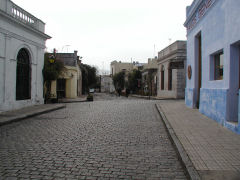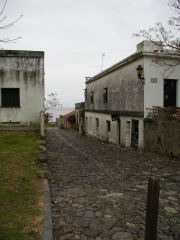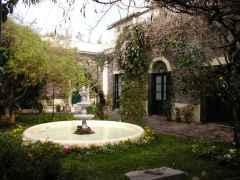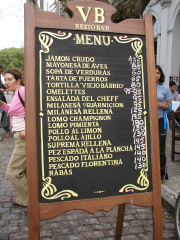 Colonia del Sacramento – It’s not really forgotten, it’s more frozen in time. Colonia is an old colonial port town in Uruguay, and our first stop after crossing the river via ferry. Truthfully, it’s sort of the Uruguayan equivalent of “colonial Williamsburg” or something of that sort. Its one real claim to fame is that it was the only place in the country that was partially occupied by the Portuguese – the rest of the country having been totally taken over by the Spanish (who also wiped out all but one family of the native indian population – that family being sold to a circus back in Europe).
Colonia del Sacramento – It’s not really forgotten, it’s more frozen in time. Colonia is an old colonial port town in Uruguay, and our first stop after crossing the river via ferry. Truthfully, it’s sort of the Uruguayan equivalent of “colonial Williamsburg” or something of that sort. Its one real claim to fame is that it was the only place in the country that was partially occupied by the Portuguese – the rest of the country having been totally taken over by the Spanish (who also wiped out all but one family of the native indian population – that family being sold to a circus back in Europe).
We’d planned on Monday afternoon wandering – a self-guided tour using a “lonely planet” guide, but as we were exiting the port, a woman was calling out from her van that she was offering city tours in both English and Spanish. After a chat with her, we decided that her knowledge and energy made it worth the huge sum of $10 apiece to spend 4+ hours with her. So, along with eight other folk from various countries, we packed into the van and headed out on a combination driving and walking tour of, as one co-tenant put it “this whole town is a museum.” The streets in the “old city” (roughly 2-300 years old) have been left with original paving stones, very little in the way of fix-up has been done.  The buildings are a combination of Spanish and Portuguese styled homes, many in disrepair, many having been converted to small museums, hotels, or restaurants.
The buildings are a combination of Spanish and Portuguese styled homes, many in disrepair, many having been converted to small museums, hotels, or restaurants.
The center of town is far more modern, most of it having been built up in the last 50-60 years, and some is quite recent. It is little more than a commercial district with surrounding residences. We also headed out to the ritzier areas where several major hotel chains have put or are putting up resort hotels.  We took a brief walk around the old bullfighting ring (built by a local businessman in 1910, only to have it shutdown when the country outlawed bullfighting in 1912). Our tour guide could not have been more charming or informative, and took time out to shuttle various folk to things like the bank, certain shops, and to other destinations (like dropping us off for our bus later to Montevideo). If you see Beatriz of City Tour as you exit the port, take her up on the offer!
We took a brief walk around the old bullfighting ring (built by a local businessman in 1910, only to have it shutdown when the country outlawed bullfighting in 1912). Our tour guide could not have been more charming or informative, and took time out to shuttle various folk to things like the bank, certain shops, and to other destinations (like dropping us off for our bus later to Montevideo). If you see Beatriz of City Tour as you exit the port, take her up on the offer!
We took some time out for lunch at a small venue at Calle de la Playa 64 (Beach Street), Victoria.  A cream of tomato and a cream of spinach soup were both delightful – full flavored and delicious. Our main courses were lacking in flavor, if not texture (sweetbreads that had not been trimmed of fat, gristle, or skin were inedible; a tough and chewy stuffed chicken breast was so overcooked it could have been anything). Heavy cream sauces drenched both – one of Uruguay’s major industries is dairy and virtually every menu item in every restaurant we saw seemed to include cream, butter, and/or cheese. One of the fun things in Uruguay is the exchange rate, which comes out to roughly 24:1 to the US dollar – menu prices and hotel bills have a tendency to look a trifle exorbitant. [Closed]
A cream of tomato and a cream of spinach soup were both delightful – full flavored and delicious. Our main courses were lacking in flavor, if not texture (sweetbreads that had not been trimmed of fat, gristle, or skin were inedible; a tough and chewy stuffed chicken breast was so overcooked it could have been anything). Heavy cream sauces drenched both – one of Uruguay’s major industries is dairy and virtually every menu item in every restaurant we saw seemed to include cream, butter, and/or cheese. One of the fun things in Uruguay is the exchange rate, which comes out to roughly 24:1 to the US dollar – menu prices and hotel bills have a tendency to look a trifle exorbitant. [Closed]
[…] So, yesterday morning found us off and floating across the river on the “high speed” (60 km/hour) ferry that takes the 55 km jaunt to this historic little town. There’s also a slow speed ferry for those who want to save some money (53 pesos each way versus 92 pesos each way), but it takes more than 3 hours to make the same trip! Last time when I visited with my friend Maureen we had iffy weather, it was winter time, and we got hit by a cyclone. It’s summertime, the weather was fantastic, and we had a delightful afternoon. It’s really a quite beautiful city, and we got to wander around, see the flowers and trees in bloom and leaf. The lighthouse was open, so we climbed to the top and took a few photos of the historic district. […]
[…] Colonia del Sacramento – At the port yesterday I was met by my, as I put it, handler, Laura Nervi. She turns out to be a charming and delightful travelling companion, she’s an agronomist for the national institute of wine, INAVI, and handles touring around folk like me in all of her spare time. We have a van and driver and our disposal for the entire four and a half day period, life is good. We started off the day with a short tour, mostly walking, around Colonia del Sacramento. We kept it a little bit cursory, since although it was part of our assigned official itinerary, I’ve been to Colonia twice before and had one in-depth tour of the city. Laura did point out that this lovely house on a corner just inside the main wall of the historic district is for sale – conditional on complete restoration to usable condition and all the associated historic preservation rules. We stopped and had coffee at El Torreón, and then, when we’d waited the appropriate amount of time, hopped back in the van and headed out just north of town for our first appointment. […]
[…] Colonia del Sacramento – It was time for that quarterly visa dance that so many of us living here on our tourist visas have to do. We have options – we can travel lots, in and out of the country; once or twice a year we can go stand in lines at the migraciones office and pay a fee for a renewal, but not every time, and only if we meet certain conditions; or we can “do Colonia“… probably the most common. It’s a quick, hour or so long trip across the river by “high speed” boat (sorry, but 55 kilometers in 70 minutes is only roughly 30 miles per hour… not exactly zooming… and I’m still mystified as to how the early morning ferry takes 3 hours to do the same trip), to the docks. There’s a daily 11:15 in the morning ferry, and the return is around 5:30. The visa process is simple and painless, right in the Buquebus terminals at each end, there are double-windowed counters – when leaving, you hand your passport to the Argentine official, who checks to make sure you haven’t overstayed your 90-days, then stamps an exit visa, and hands it to the Uruguayan official siitting next to him or her, who barely glances at it, other than perhaps to see if your picture matches you, and then stamps a 90-day entry visa to Uruguay. The process is reversed on the way back. […]